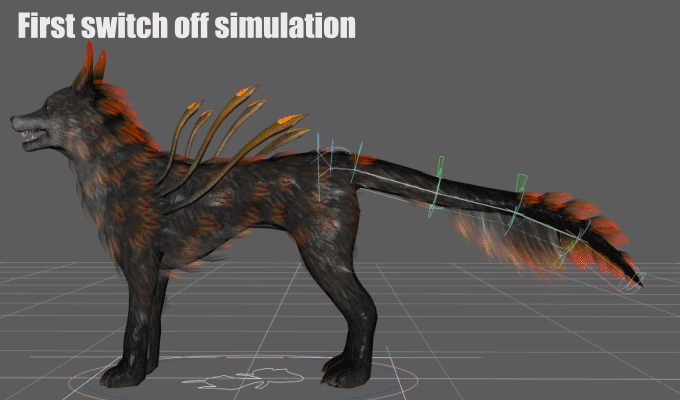Quick tail setup


In this tutorial you'll learn how to setup a tail with physics and how to steer the look and feel of the simulation using normal keyframing techniques. We'll use one of the excellent rigs by Truong CG Artist.
Optional example files
Walkcycle
Let's start with a walkcycle, and move towards interacting with the environment.
Apply Simulation
Select the hip followed by each tail control along the tail in order, and click Create Dynamic Control.

Reduce Gravity
This particular rig is very small, about 1.6 cm tall, so we need to reduce the default Gravity to reflect this.

Global Strength
The first selected Dynamic Control contains a Guide Multiplier to influence the strength on all of the tail controls at the same time.

Local Strength
You can also adjust the strength values individually for each joints, to taper their stiffness along the length of the tail.

Strength Falloff
Let's taper the strength along the length of the tail.

Result
Let's see how it looks.

Sitting Down
Now let's see how to steer our simulation with regular keyframes.
Switch to Animation
The simulation will try to follow your keyframe animation. Just switch off the Simulated attribute on the root control while you're animating, then switch it back on to see how it looks.

Animation vs Simulation
You can see the animation input on the left and the resulting simulation on the right. With just 3 keyframed poses we end up with this result. Note that I had to overcompensate my animation poses to fight gravity when the tail swings around.

Advanced Control
Gain even more fine-grained control with these advanced topics.
Flex and Relax Muscles
By keyframing the root strength multiplier you can flex or relax the muscles in the tail. The higher the value the stiffer it gets and the lower the value the more relaxed it becomes, allowing gravity to drop it to the ground.

Damping
Damping controls how fleshy and sluggish your simulation behaves.

Low or zero damping preserves more energy in the system, making a simulation more elastic or rubbery. Creatures and humans tend to look best with moderate to high damping values.